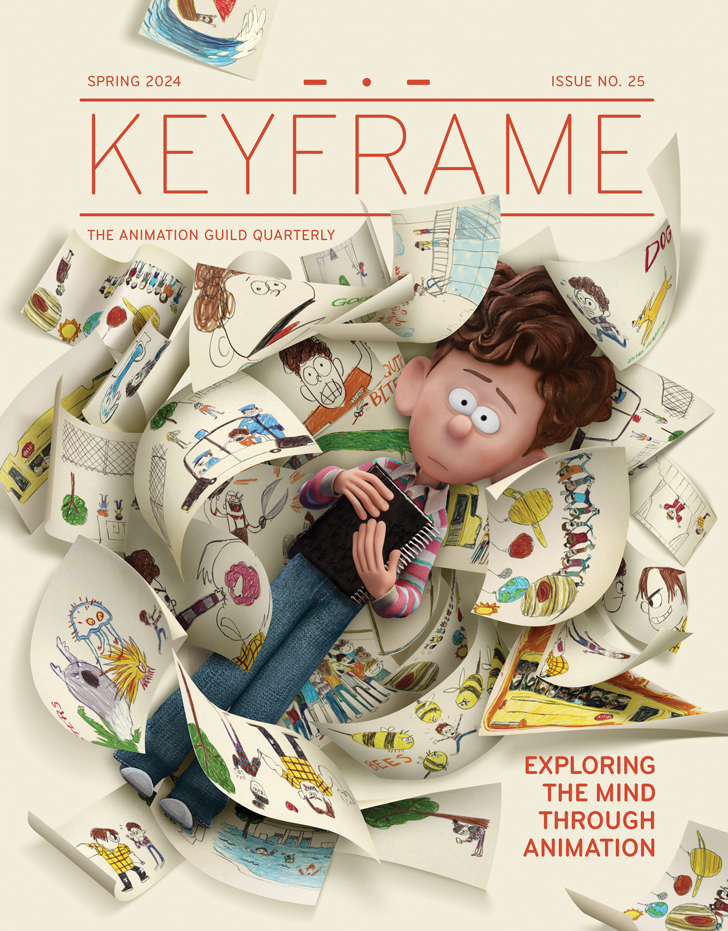
Tell us a little about yourself and your career.
My name’s Alayna Cabral, and I’ve been a Storyboard Artist in TV animation for six years. I’ve always been drawn to storytelling and cartoons—making comics, writing characters, doodling on every margin in every notebook. Art was not only a form of self expression for me, but it was also a way to find connection and community.
I grew up in Massachusetts and went to college for animation at the Massachusetts College of Art in Boston. I graduated in 2016 and worked for a small studio until moving to L.A. in the fall of 2017. I didn’t have much of a plan at firstCI just really wanted to work in TV and film, plus the weather was nice. I ended up landing my first job in animation in the summer of 2018 as a Storyboard Artist for The Jim Henson Company on the preschool show Dinosaur Train. That’s when things started to pick up—after that job ended, I worked at Warner Bros. Animation on the show Thundercats ROAR!, and after that I worked at Disney Television Animation on The Ghost and Molly McGee. I’ve been storyboarding at DTVA to this day. I’m currently storyboarding on Primos.

What challenges have you faced in navigating a career in animation?
When I first started out, it felt like there was a huge distance between where I was and the place I wanted to be. I felt wholly underprepared. In college, I wanted to become a Character Animator and mainly focused on that for my whole time in school—I wasn’t even thinking about storyboarding yet. It wasn’t until well after college that my attention turned to storyboarding.
The thought of using my animation skills in conjunction with my love for comics and sequential art very much appealed to me. But it also meant overhauling my portfolio from what I had studied for years to an entirely new thing, and compared to people who had studied storyboarding longer, I felt very behind. I was lucky that people saw potential in me through my animation work and were patient enough to teach me further—so much of what I know now was learned on the job. I’m very thankful for the opportunities I had to pick up these skills, as they’ve not only made me a better storyboard artist but a better artist in general.

Who are your inspirations in the field of animation?
Too many to list! I’m greatly inspired by independent animation and short film—I love seeing the variety in art and animation styles, as well as the stories you see in short films. Sally Cruikshank, Joanna Quinn. Felix Colgrave, and Don Hertzfeldt are just a few of my favorite short filmmakers. I’m also a big fan of Masaaki Yuasa’s feature films and shorts—Mind Game is an all-time favorite.
What do you hope to accomplish as an artist in the animation industry?
I want to be able give a piece of my voice to every project I work on. With many of the shows that I’ve been lucky enough to be part of, I’ve been given a lot of freedom and encouragement to pitch new ideas. It’s a great way to work—everyone in the pipeline has a voice, and when you see the final product, everyone who touched it contributed something important and it really feels like it’s theirs. That’s the beauty of working in animation—the open, collaborative nature. And it’s why I love working in storyboards specifically. There are so many opportunities to pitch.
I love making people laugh when I pitch, and seeing them light up when I light up. I love the feeling of when I have something good going. There’s a spark when you’re really entertaining people—a positive energy that fills the room, bouncing from you to them and back to you. It’s what art is all about. That’s what I want to do with my art all the time, and keep doing for the unforeseeable future.
What does being in the Union mean to you?
I was working non-union animation gigs before moving to L.A., and my life changed when I got my first Union job. I never imagined the level of solidarity I would have working as an artist. People in the Union inspire me and always tell me what I need to hear—that I work hard, that I deserve a livable wage, that my labor rights are worth fighting for. Everybody deserves to see what their labor is truly worth and not have their wages stolen by greed. That’s the power that labor movements can give us working class people.
Learn more about Alayna at her website.
Follow her on Instagram.









.png)